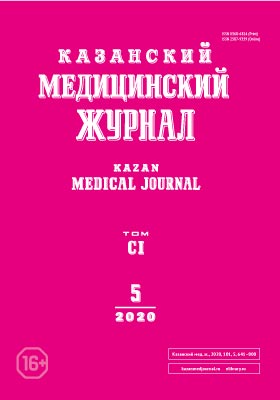Риск развития синдрома удлинённого интервала QT при новой коронавирусной инфекции COVID-19
- Авторы: Ослопов В.Н.1, Ослопова Ю.В.2, Хазова Е.В.1, Сергиенко К.С.1, Мурзаханова А.Ф.1, Бойчук Ю.М.1
-
Учреждения:
- Казанский государственный медицинский университет
- Казанский (Приволжский) федеральный университет
- Выпуск: Том 101, № 5 (2020)
- Страницы: 749-753
- Раздел: Обмен клиническим опытом
- Статья получена: 25.08.2020
- Статья одобрена: 25.09.2020
- Статья опубликована: 27.10.2020
- URL: https://kazanmedjournal.ru/kazanmedj/article/view/43119
- DOI: https://doi.org/10.17816/KMJ2020-749
- ID: 43119
Цитировать
Аннотация
Статья посвящена риску развития поражений со стороны сердечно-сосудистой системы при коронавирусной инфекции. В марте 2020 г. Всемирная организация здравоохранения объявила пандемию COVID-19. Вирус поставил перед практикующими врачами массу задач, среди которых исследование его патогенеза и создание терапии, подходящей всем группам пациентов. В статье представлены сведения о попадании коронавируса в клетку, развитии поражений со стороны сердечно-сосудистой системы, в частности сердца, и последние данные об экспериментальной терапии гидроксихлорохином. Было показано, что COVID-19 влияет на синтез ангиотензина-2, увеличивая интервал QT. Вместе с тем комбинированное применение хлорохина вместе с азитромицином вызывало критическое удлинение интервала QT у некоторых пациентов. Уже 4 июля 2020 г. Всемирная организация здравоохранения в связи с рекомендациями Международного руководящего комитета клинического исследования «Solidarity» остановила испытания данных препаратов. Именно кардиологам предстоит не только проанализировать будущие результаты исследований о влиянии коронавируса на сердечно-сосудистую систему, но и составить на основе этого рекомендации по ведению и лечению тяжёлых пациентов.
Ключевые слова
Полный текст
Об авторах
Владимир Николаевич Ослопов
Казанский государственный медицинский университет
Email: kostya_s99@mail.ru
Россия, г. Казань, Россия
Юлия Владимировна Ослопова
Казанский (Приволжский) федеральный университет
Email: kostya_s99@mail.ru
Россия, г. Казань, Россия
Елена Владимировна Хазова
Казанский государственный медицинский университет
Email: kostya_s99@mail.ru
Россия, г. Казань, Россия
Константин Станиславович Сергиенко
Казанский государственный медицинский университет
Автор, ответственный за переписку.
Email: kostya_s99@mail.ru
Россия, г. Казань, Россия
Аделя Фанисовна Мурзаханова
Казанский государственный медицинский университет
Email: kostya_s99@mail.ru
Россия, г. Казань, Россия
Юлия Михайловна Бойчук
Казанский государственный медицинский университет
Email: kostya_s99@mail.ru
Россия, г. Казань, Россия
Список литературы
- Stokes E.K., Zambrano L.D., Anderson K.N. et al. Coronavirus disease 2019 case surveillance — United States, January 22 — May 30, 2020. MMWR Morb. Mortal. Wkly. Rep. 2020; 69; 759–765. doi: 10.15585/mmwr.mm6924e2.
- Kuba K., Imai Y., Rao S. et al. A crucial role of angiotensin converting enzyme 2 (ACE2) in SARS coronavirus-induced lung injury. Nat. Med. 2005; 11 (8): 875–879. doi: 10.1038/nm1267.
- Варданян Я.Т. COVID-19 и повышение риска развития желудочковых аритмий у пациентов с синдромом удлинённого интервала QT. Молодой учёный. 2020; (14): 99–102.
- Khashkhusha T.R., Chan J.S.K., Harky A. ACE inhibitors and COVID-19: We don't know yet. J. Card. Surg. 2020; 35 (6): 1172–1173. doi: 10.1111/jocs.14582.
- Greber U.F., Singh I., Helenius A. Mechanisms of virus uncoating. Trends Microbiol. 1994; 2 (2): 52–56. doi: 10.1016/0966-842x(94)90126-0.
- Ослопова Ю.В., Ослопов В.Н. Экстрасистолия (состояние проблемы, мембранные аспекты патогенеза и лечения). Монография. Казань: Меддок. 2012; 300 с.
- Wu C.I., Postema P.G., Arbelo E. et al. SARS-CoV-2, COVID-19, and inherited arrhythmia syndromes . Heart Rhythm. 2020; 17 (9): 1456–1462. doi: 10.1016/j.hrthm.2020.03.024.
- Zhou D., Dai S.M., Tong Q. COVID-19: a recommendation to examine the effect of hydroxychloroquine in preventing infection and progression. J. Antimicrob. Chemother. 2020; 75 (7): 1667–1670. doi: 10.1093/jac/dkaa114.
- White N.J. Cardiotoxicity of antimalarial drugs. Lancet Infect. Dis. 2007; 7 (8): 549–558. doi: 10.1016/S1473-3099(07)70187-1.
- Liu J., Cao R., Xu M. et al. Hydroxychloroquine, a less toxic derivative of chloroquine, is effective in inhibiting SARS-CoV-2 infection in vitro. Cell Discov. 2020; 6: 16. doi: 10.1038/s41421-020-0156-0.
- Ramireddy A., Chugh H., Reinier K. et al. Experience with hydroxychloroquine and azithromycin in the coronavirus disease 2019 pandemic: Implications for QT interval monitoring. J. Am. Heart Assoc. 2020; 9 (12): e017144. doi: 10.1161/JAHA.120.017144.
- Mitra R.L., Greenstein S.A., Epstein L.M. An algorithm for managing QT prolongation in coronavirus disease 2019 (COVID-19) patients treated with either chloroquine or hydroxychloroquine in conjunction with azithromycin: Possible benefits of intravenous lidocaine. Heart Rhythm. Case Rep. 2020; 6 (5): 244–248. doi: 10.1016/j.hrcr.2020.03.016.
- Колоцей Л.В., Снежицкий В.А., Ардашев А.В. Алгоритмы медикаментозной терапии коронавирусной инфекции (COVID-19) у пациентов с удлинением интервала QT. Ж. Гродненского гос. мед. ун-та. 2020; 18 (2): 203–210. doi: 10.25298/2221-8785-2020-18- 2-203-210.
- Шляхто Е.В., Конради А.О., Виллевальде С.В. и др. Руководство по диагностике и лечению болезней системы кровообращения (БСК) в контексте пандемии COVID-19 (краткая версия). 2020; 10. https://scardio.ru/content/Guidelines/COVID-19.pdf (дата обращения: 15.08.2020).
- Sapp J.L., Alqarawi W., MacIntyre C.J. et al. Guidance on minimizing risk of drug-induced ventricular arrhythmia during treatment of COVID-19: A statement from the Canadian Heart Rhythm Society. Can. J. Cardiol. 2020; 36 (6): 948–951. doi: 10.1016/j.cjca.2020.04.003.
Дополнительные файлы







